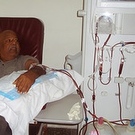Kidney Failure In Multiple Myeloma Patients – Part 3: Time and Care Commitments
Published: Jul 21, 2009 12:43 pm

For those with multiple myeloma, kidney impairment treatments may become a significant part of their myeloma treatment, affecting their daily lives. These treatments require an amount of time and care that may impact patients’ daily schedules and long-term plans.
Wherever a patient goes for treatment, the health care providers there will make sure his fluid intake is right for his condition. Often, patients will have to stay in a hospital overnight to be monitored and to receive other treatments, which might include certain drugs and intravenous fluids. (For more details on kidney failure treatments, please see the related Beacon article.)
Because acute kidney failure can progress quickly in people with multiple myeloma, the need for this hospital visit may come up suddenly, disrupting patients’ schedules and causing stress. Drug therapies may continue after the initial hospital visit.
Depending on patients’ eligibility, doctors may prescribe a plasmapheresis, or plasma exchange, regimen. The procedure takes one to three hours. After that, most people can return to most of their normal activities.
In a paper published in the journal Leukemia, doctors from the University of Athens School of Medicine report that for their patients, they repeat a plasma exchange procedure every two or three days to a maximum of four or five sessions. This means that people undergoing plasma exchange for myeloma-related kidney failure will spend a small part of their day getting treatment every few days for less than two weeks. Plasmapheresis usually is not a long-term treatment.
For more severe kidney failure, in which most of the kidney’s ability is lost, patients need to have hemodialysis or peritoneal dialysis. Hemodialysis filters the blood through a machine. It is the most common form of dialysis, and often what people mean when they talk about dialysis. Peritoneal dialysis uses the filtering ability of the peritoneum, or the lining of the abdomen, to clean the blood. A special fluid called the dialysate is introduced into the abdomen. The dialysate draws wastes from the blood into the peritoneum. Then the fluid is drained out of the body and thrown away.
People undergoing hemodialysis will usually visit either a standalone dialysis center or a hospital three to four times a week for three to five hours at a time.
Patients can also have hemodialysis at home on varying schedules, including shorter but more frequent treatments and nighttime treatments. People who use home hemodialysis report that they have more energy, sleep better, and enjoy better quality of life.
However, those who choose this option will have to take on the responsibility for monitoring their own progress, making sure they are getting enough treatments, and maintaining their dialysis machine. Usually, they will need someone to help them, such as a family member or a friend. The helper and the patient have to be trained for four to eight weeks, according to DaVita, a company that provides dialysis facilities to more than 2,000 clinics and hospitals in the United States.
Peritoneal dialysis requires daily treatments on varying schedules, amounting to several hours a day, depending on the type of peritoneal dialysis patients and their doctors choose. Three major types are continuous ambulatory peritoneal dialysis, continuous cycling peritoneal dialysis, and intermittent peritoneal dialysis. For all peritoneal dialysis types, a doctor will put a small, soft, flexible tube called a catheter in the patient’s abdomen. The dialysate goes into the abdomen through the catheter. The catheter will stay there permanently, and the patient will have to keep it clean and dry.
Peritoneal dialysis is often done at home, at work, or while traveling. For continuous cycling peritoneal dialysis and intermittent peritoneal dialysis, most or all of the hours required are fulfilled at night, while the patient is sleeping. Training for patients and any helpers takes two weeks, according to DaVita.
People undergoing any kind of kidney dialysis will need to make changes to their diets as directed by their doctors and may need some additional medications. Otherwise, if there are no complications, patients can go on with most of their daily activities when they are not getting treated. Though travel may be difficult for patients undergoing dialysis, a recent article in a Madison, Wisconsin newspaper included the story of Sabine Lobitz, who has multiple myeloma and travels with her home hemodialysis equipment. To read more about Ms. Lobitz, please see the Capital Times article.
Managing multiple myeloma-caused kidney failure takes up a significant amount of patients’ time and attention, but there are many options for treatment, so patients can choose what will work best for them.
For more information on kidney failure in multiple myeloma, please see the other Beacon articles in this series and related Beacon news articles.
Time Needed for Major Kidney Failure Treatments for Multiple Myeloma Patients
|
Treatment
|
Time Needed for One Session
|
Frequency of Sessions
|
Length of Overall Regimen
|
||
|
Plasmapheresis
|
1-3 hours
|
Every 2-3 days
|
Maximum of 5 sessions
|
||
|
Hemodialysis
|
|||||
|
3-5 hours
|
3-4 times a week
|
Varies, up to lifetime dependency
|
||
|
3-5 hours
|
3-4 times a week
|
|||
|
About 2 hours
|
5-7 times a week
|
|||
|
6-8 hours
|
6 times a week or every other night
|
|||
|
Peritoneal dialysis
|
|||||
|
3-6 hours*, with 30 minutes of draining
|
4-6 times every day
|
Varies, up to lifetime dependency
|
||
|
8-12 hours
|
Nightly, with 1-2 short draining sessions during the day
|
|||
|
8-12 hours
|
Nightly
|
|||
*Unlike the other treatments in this table, people using continuous ambulatory peritoneal dialysis can stay mobile during this time. They only need to tend to their dialysis during the 30-minute draining time
Related Articles:
- None Found

